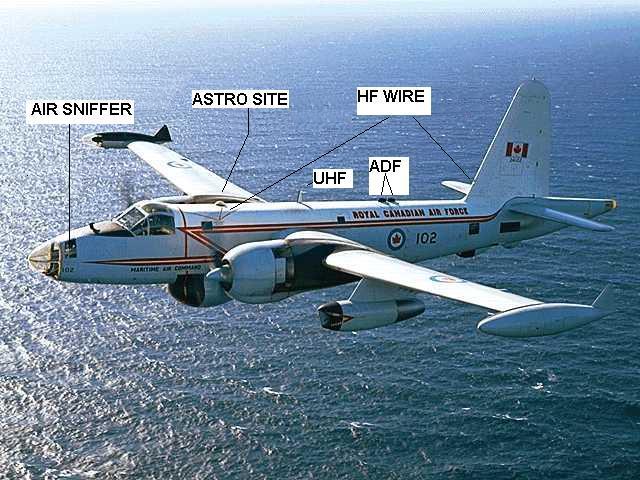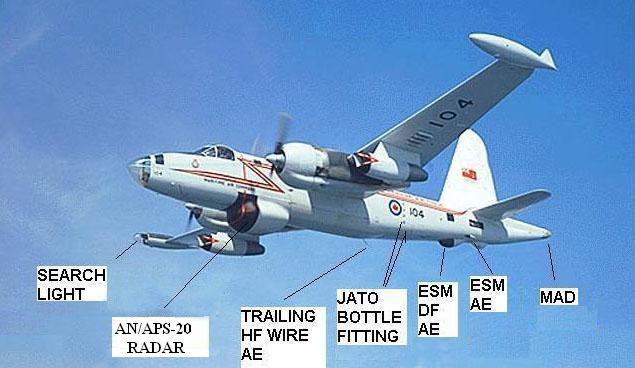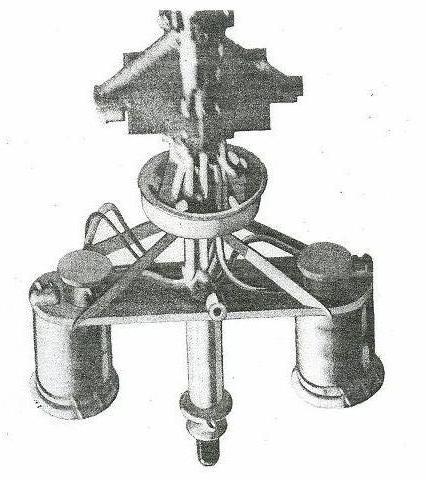RCAF Neptune Electrical System
The electrical generating system consisted of two DC generators mounted
the starboard engine and another DC generator plus an AC generator mounted
on the port engine, an adequate system for the ASW package in the aircraft
when it was delivered. However, around 1960, the Julie-Jezebel system modifications
created a weak point in the electrical system in that, with all the ASW
equipment in use, the DC load suddenly thrown on a single generator (if,
for instance, the starboard engine were shut down) would severely overload
that generator probably causing it to disconnect which would throw the
load on the batteries depleting them in a matter of a few minutes. With
a starboard engine failure on takeoff, the engine had to be left wind milling
long enough to shed enough electrical load so that the single DC generator
wouldn't be overloaded. The result could be a complete electrical failure.
It was considered that this condition posed no extra risk to local flying
such as pilot and flight engineer training when the ASW equipment was not
in operation.
The device labelled as "air sniffer" is properly called the sensor for
the Exhaust Trail Indicator (ET1). This device was intended to detect
the diesel exhaust from Russian diesel submarines. To be effective, the
aircraft had to fly at a dangerously low altitude of around 150 feet,
something the pilot did not really want to do.
 |
| Neptune principal topside features.
(Canadian Forces
Photo) |
 |
| Neptune principal underside features AE= antenna. MAD = Magnetic Anomaly
Detector. The 'bump' aft of the ESM DF antenna is a tail skid to protect
the MAD boom. The upper collision light is on top of the tail fin.
(Canadian
Forces Photo) |
The era of the Neptune's electronics suite shown below is not known
this time. Nearly all of this equipment appeared on a single page in one
of the Neptune manuals.
AN/APR-9 ESM TUNERS
AE= antenna
| TUNER |
TUNER
RANGE (MHz) |
SEARCH
AE |
SEARCH AE
RANGE (MHz) |
DF ANTENNA |
DF AE RANGE |
|
|
|
|
|
|
| TN128/APR9 |
1,000 - 2,600 |
Lockheed
616097 |
1,000 - 4,450 |
AS5-21 (XP1)
APA69 |
1,000 to
10,750 MHz |
| TN129/APR9 |
2,300- 4,450 |
| TN130/APR9 |
4,300- 7,350 |
Lockheed
616096 |
4,150 - 10,750 |
| TN131/APR-9 |
7,050 - 10,750 |
AN/UPD-501 SHF DF RECEIVER
The UPD-501 was a High Probability Radar Early Warning directional finding
receiver which was used to detect radar emissions on the SHF radar bands
and gave some indication of the frequency in use, bearing, and the antenna
rotation period. The receiver was connected to an airborne version of a
horn antenna assembly.
This device was the outcome of a project initiated by Naval Headquarters,
and was a contemporary of the early MAD work. It was a wide-band
dual-band electronic countermeasures (ECM) receiver system. This
project was started in the early 1950s by the National Research Council
who undertook to develop "a simple “instantaneous” direction-finding receiver-display
for detection of non-co-operative radar transmissions expected to be of
short duration". It was designed to listen for radar emissions from
submarines, surface vessels and even aircraft.
When the UPD-501 was fitted to the Neptunes, it did not prove viable,
at least in the East Coast squadrons. The plan was to attach the
antennae “cans” to the bottoms of the wing tip tanks, but there were problems
with the mounting brackets due to cracking. In some cases the receiver
was removed from the aircraft once the cracks were detected. Also, the
UPD-501 set was damaged if it and the radar were both turned on at the
same time. Curiously, these factors do not appear to have posed a
problem for Comox-based 407 Squadron, whose Lancasters and Neptunes were
equipped with the AN/UPD-501. [1]
EXHAUST GAS DETECTOR (AUTOLYCUS) also called ASH
The Exhaust Gas Detector was a device used to measure the quantity of
particulate matter in the air. A venturi type device was mounted up near
the nose and a hose connected it to the 'black box' where the incoming
air was humidified and then passed through a chamber. There was a
light on one side of the chamber and photoelectric sensor on the other.
The relative quantity of particulate matter was displayed on the AJH(?)
501 chart recorder using a heated stylus. As the thermal paper was drawn
through the recorder below the stylus, it would leave a track on the paper.
The same recorder also used for Julie (EER).
The aircraft flew very low over water hemstitching upwind, looking for
a submarine diesel exhaust trail. Once detected the a/c would crisscross
the exhaust plume while working its way up wind, up the trail. The
width of the trail would normally narrow as the aircraft got closer to
the origin. To be effective, the aircraft had to be very low,
something the pilots hated. Once a target was found, it would be illuminated
with the searchlight and then depth-charged. It was nice in theory but
the pilots weren't very thrilled with it since that was a technique and
technology left over from WWII.
JULIE and JEZEBEL SONOBUOY SYSTEMS
JEZEBEL
JEZEBEL is a passive sonobuoy system which was used for area searches
and localization only so far as the 16 sonobuoy channels of the SSQ-2B
system would provide. JEZEBEL processes sound information by analyzing
the sounds in the sea into their frequency components and displaying
the information on a continuously moving graph in a frequency vs. time
format. Each type of surface ship and submarine has a unique frequency
"fingerprint" that allowed the JEZEBEL operator to identify the type and
the nationality of the target. The technical term for JEZEBEL was "LOw
Frequency Analysis and Recording" or LOFAR. Once a submarine was detected
with JEZEBEL, then JULIE was used to help refine the position. . Incidentally,
the 15-buoy JULIE circle was nicknamed "the Cadillac pattern" as one could
allegedly buy a car for the price of the buoys.
The AQA-3 and AQA-4 were the recorders used for JEZEBEL. The AQA-3 used
four 3", side-by-side, printouts of continuous input - frequency on the
X axis and time on the Y axis. The West Coast Neptunes may have been
fitted with the AQA-4 later in their service lives. The only difference
between the -3 and -4 was an additional knob on the AQA-4 for a 'correlate'
function since it could perform a correlation/detection (CODAR) analysis.
JULIE
JULIE was an active sonobuoy system which used the technique called
Explosive Echo Ranging (EER). After the sonobuoys were deployed,
the aircraft would then drop a small explosive charge into the water known
as a Practice Depth Charge (PDC). When it exploded, the percussion wave
would bounce off the submarine and the operator would listen for the resultant
echo. The system used a paper tape printing recorder and 'Julie
rulers' which were calibrated for distance based on ocean temperature.
The disadvantage of JULIE is that the PDC detonations announce to the
submarine that it is about to be attacked. Naturally, the submarine executes
the maximum evasive manoeuvres (dispense decoys, change depth, turn and
take advantage of oceanographic features that would minimize JULIE detection
ranges). A well worked up crew (JULIE demanded the highest degree of crew
coordination) could attack an evasive submarine before it could exit the
JULIE sonobuoy containment pattern. If the submarine increased speed, it
generated more noise and increased JEZEBEL detection ranges.
By the way, two buoys (SSQ-2B Mod 9) bombed with PDCs would give an
ambiguous fix (the arcs would intersect on both sides of the baseline),
so a third buoy would be needed to 'resolve the ambiguity' or, alternatively,
carry out a MAD sweep across both fixes to see which one was the correct
one.
A regular passive sonobuoy could be used for JULIE but it was more expensive
to do so. Initially, only one type of sonobuoy was used for JULIE and JEZEBEL
but later there were 'dedicated' buoys for each system. The dedicated JULIE
sonobuoy was less sophisticated and cheaper because all that was needed
was a sensor to detect the PDC "white noise" detonation and the returning
echo. Whereas the JEZEBEL sonobuoys were more sophisticated because they
were frequency sensitive. There were other design techniques inherent in
a JEZEBEL buoy which were used to dampen the ambient sea noise (rain, wave
motion, sea life, flow noise around the hydrophone, etc). Later, in the
post-Neptune era, a more sophisticated "DIrectional Frequency Analysis
and Recording" or DIFAR sonobuoy also provided direction to the frequency
source. JULIE was the only EER system. It was supplanted by active
sonobuoys that generated their own "ping" similar to a ship's sonar, negating
the requirement to drop PDCs.
After the initial detection a submarine was a localized by refining
the datum down to attack criteria. In broad terms, one could look at the
detection system as getting more accurate when going from SOSUS to JEZEBEL
to JULIE to MAD. Getting from JEZEBEL to JULIE often required a visual
or radar contact though, especially on a snorkelling submarine.
Generally, an acoustic operator was trained to operate both JULIE and
JEZEBEL systems. But most Neptune crews operated JEZEBEL and JULIE
simultaneously requiring two operators. In the Neptune era, the usual tactical
sequence was to detect the submarine initially on JEZEBEL and determine
a "rough" fix on its position; then JULIE was used to refine the submarine's
position to sufficient accuracy to conduct a multiple torpedo attack. MAD
was used during the attack run to confirm the accuracy of the JULIE datum
on which the attack was made. Meanwhile the JEZEBEL operator continued
to track the submarine, providing indications that the submarine had turned
or changed depth.
FOOTNOTES:
[1] As noted in the article "Early Cold War Anti-Submarine Warfare Development
in Canada" by Leo Pettipas.
The exact reason as to why the UPD-501 was more successful in the West
is not known at this time.
[2] From the Naval Institute Guide to World Naval Weapons Systems,
1991/92 by Norman Friedman.




